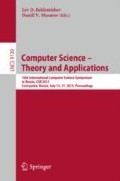Abstract
We prove a version of a “Reverse Newman Theorem” in information complexity: every private-coin communication protocol with information complexity I and communication complexity C can be converted into a public-coin protocol with the same behavior so that it’s information complexity does not exceed \(O\left( \sqrt{IC}\right) \). “Same behavior” means that the transcripts of these two protocols are identically distributed on each pair of inputs. Such a conversion was previously known only for one-way protocols. Our result provides a new proof for the best-known compression theorem in Information Complexity.
Access this chapter
Tax calculation will be finalised at checkout
Purchases are for personal use only
References
Barak, B., Braverman, M., Chen, X., Rao, A.: How to compress interactive communication. SIAM J. Comput. 42(3), 1327–1363 (2013)
Braverman, M.: Interactive information complexity. In: Proceedings of the 44th Symposium on Theory of Computing, pp. 505–524. ACM (2012)
Braverman, M., Garg, A.: Public vs private coin in bounded-round information. In: Esparza, J., Fraigniaud, P., Husfeldt, T., Koutsoupias, E. (eds.) ICALP 2014. LNCS, vol. 8572, pp. 502–513. Springer, Heidelberg (2014)
Brody, J., Buhrman, H., Koucky, M., Loff, B., Speelman, F., Vereshchagin, N.: Towards a reverse newman’s theorem in interactive information complexity. In: 2013 IEEE Conference on Computational Complexity (CCC), pp. 24–33. IEEE (2013)
Kushilevitz, E., Nisan, N.: Communication Complexity. Cambridge University Press, Cambridge (2006)
Newman, I.: Private vs. common random bits in communication complexity. Inf. Process. Lett. 39(2), 67–71 (1991)
Pankratov, D.: Direct sum questions in classical communication complexity. Master’s thesis, University of Chicago (2012)
Author information
Authors and Affiliations
Corresponding author
Editor information
Editors and Affiliations
Rights and permissions
Copyright information
© 2015 Springer International Publishing Switzerland
About this paper
Cite this paper
Kozachinskiy, A. (2015). Making Randomness Public in Unbounded-Round Information Complexity. In: Beklemishev, L., Musatov, D. (eds) Computer Science -- Theory and Applications. CSR 2015. Lecture Notes in Computer Science(), vol 9139. Springer, Cham. https://doi.org/10.1007/978-3-319-20297-6_19
Download citation
DOI: https://doi.org/10.1007/978-3-319-20297-6_19
Published:
Publisher Name: Springer, Cham
Print ISBN: 978-3-319-20296-9
Online ISBN: 978-3-319-20297-6
eBook Packages: Computer ScienceComputer Science (R0)

